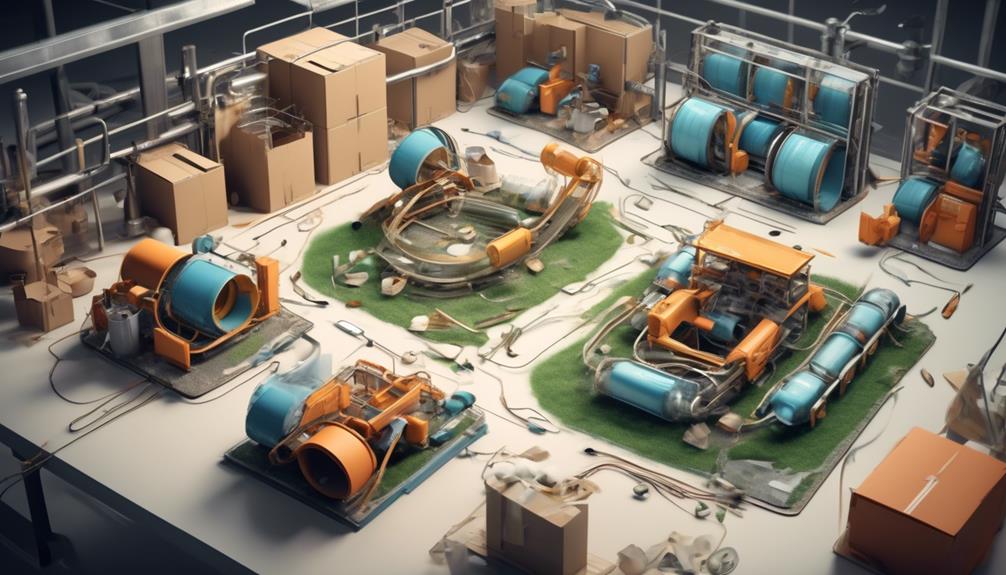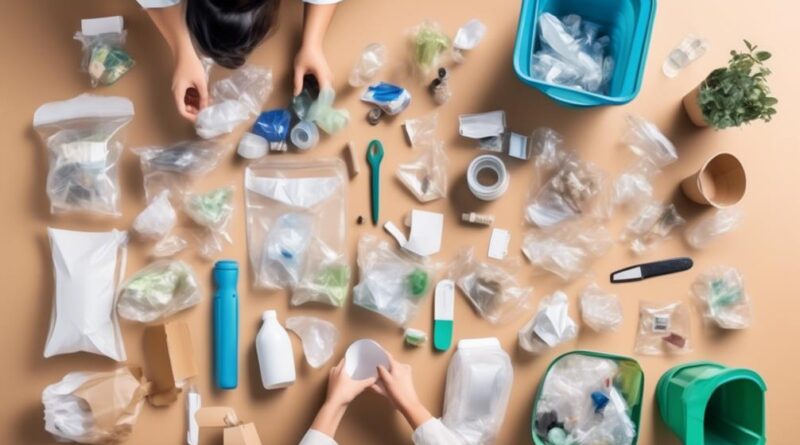15 Innovative Tips for Achieving Zero Waste Recycling
If you're seeking sustainable solutions to shrink your environmental footprint, the path to zero waste recycling is paved with practical and pioneering principles.
With the landscape of waste management rapidly evolving, you may be wondering how to navigate this terrain. Fear not, as we have compiled a comprehensive compendium of cutting-edge strategies that will propel you toward a more eco-conscious existence.
From reimagining refuse to reinvigorating resources, these 15 innovative tips will revolutionize your approach to recycling and redefining waste.
Upcycling Household Items
One simple way to reduce household waste is by upcycling everyday items that you'd normally throw away. Repurposing furniture and engaging in creative DIY projects can significantly contribute to minimizing waste.
Instead of discarding old furniture, consider giving it a fresh look through upcycling. For instance, an old wooden chair can be transformed into a stylish new piece by sanding it down, repainting it, and adding new upholstery. This not only prevents the chair from ending up in a landfill but also gives it a new lease on life, adding character and uniqueness to your home decor.
Creative DIY projects are another excellent way to upcycle household items. For example, you can repurpose glass jars into trendy candle holders or storage containers. By doing so, you give these items a new purpose, reducing the need to purchase new ones and preventing the glass jars from being thrown away.
Additionally, instead of buying new decorations, you can create your own using materials that would otherwise be discarded. This not only reduces waste but also allows you to personalize your living space according to your taste and style.
Composting Food Scraps
To reduce food waste and contribute to a more sustainable lifestyle, consider composting your food scraps. Composting is a simple and effective way to reduce methane emissions and enrich soil. When food scraps end up in landfills, they decompose without access to oxygen, leading to the release of methane, a potent greenhouse gas. By composting these scraps instead, you can significantly reduce methane emissions while creating a nutrient-rich soil amendment for your garden or potted plants.
Composting food scraps is a straightforward process that can be done in your backyard or even in a small indoor bin. Start by collecting fruit and vegetable scraps, coffee grounds, eggshells, and other organic waste. Avoid adding meat, dairy, and oily foods as they can attract pests and create odor issues. Layer the food scraps with yard waste like grass clippings, leaves, and twigs to create a balanced mix of greens and browns. Turn the compost regularly to aerate it and speed up the decomposition process.
Over time, the organic matter will break down into a dark, crumbly substance known as 'black gold,' which can be mixed into your garden soil to improve its structure and fertility.
Implementing a Reusable Packaging System
Consider implementing a reusable packaging system to reduce the environmental impact of your waste and contribute to a more sustainable future. Reducing waste is crucial in the journey towards achieving zero waste recycling.
By incorporating sustainable packaging solutions, you can significantly minimize the amount of single-use packaging materials that end up in landfills or polluting the environment.
One effective way to reduce waste is by utilizing durable, reusable containers for storing and transporting goods. These containers can be used multiple times, cutting down on the need for disposable packaging. Additionally, opting for materials like glass, steel, or durable plastics for packaging can decrease the reliance on single-use plastics and other non-biodegradable materials.
Another approach is to implement a closed-loop system where packaging is returned, cleaned, and reused. This method not only reduces the amount of packaging waste but also promotes a more sustainable and circular approach to packaging usage.
Furthermore, encouraging customers to bring their own reusable bags or containers when shopping can also contribute to waste reduction. Offering incentives such as discounts or rewards for customers who bring their own packaging can help incentivize the use of reusable options.
Embracing Precycling Strategies
Embrace precycling strategies by evaluating the packaging and products you bring into your home to minimize waste from the start. Reducing packaging and rethinking consumption are key elements in embracing precycling. Before making a purchase, consider the amount of packaging involved. Opt for products with minimal or recyclable packaging. When possible, choose bulk items to reduce the overall packaging waste.
Sustainable shopping and mindful purchasing play a crucial role in precycling. Look for products with eco-friendly packaging or those that come in reusable containers. When shopping, consider the longevity of the product and its packaging. Investing in durable, long-lasting items reduces the overall waste generated. Additionally, support brands that prioritize sustainable packaging and environmentally friendly practices.
Embracing precycling strategies also involves challenging the status quo of consumption. Evaluate your shopping habits and strive to make more sustainable choices. Consider whether you truly need a product or if there are alternative options with less packaging. Embracing a minimalist mindset can significantly reduce the amount of waste generated from unnecessary purchases.
Mindful purchasing involves being conscious of the environmental impact of the products you buy. By embracing precycling strategies, you actively contribute to reducing waste at the source. Remember, every small change in your purchasing habits contributes to a more sustainable and eco-friendly lifestyle.
Engaging in Community-Based Recycling Programs
Challenging the status quo of consumption by participating in community-based recycling programs is a proactive way to minimize waste and promote sustainability. Engaging in neighborhood cleanups not only helps to beautify the community but also plays a significant role in waste reduction. By organizing or participating in these cleanups, you can directly contribute to the proper disposal of waste and the recycling of materials that would otherwise end up in landfills.
Additionally, involving yourself in school recycling initiatives can have a lasting impact on the environment. Encouraging students to recycle paper, plastic, and other materials not only instills good habits from a young age but also reduces the amount of waste generated by educational institutions. By actively engaging in these programs, you can help create a culture of sustainability within your community and encourage others to do the same.
Furthermore, community-based recycling programs provide an opportunity to educate and raise awareness about the importance of waste reduction and recycling. By participating in these initiatives, you can inspire others to take action and become more conscious of their consumption habits. This collective effort can lead to a significant decrease in the amount of waste generated within your community, ultimately contributing to a more sustainable and environmentally friendly way of living.
Utilizing Zero Waste Stations
When utilizing zero waste stations, remember to separate your recyclables from your non-recyclable waste to ensure proper disposal. Waste reduction is a crucial aspect of utilizing these stations. By separating your waste, you're actively participating in reducing the overall waste that ends up in landfills. This simple act contributes to a more sustainable environment and helps in conserving natural resources.
Recycling innovation is also a key component of zero waste stations. These stations are equipped with innovative recycling solutions that make it easier for you to sort and dispose of your waste responsibly. They often have separate compartments for different types of materials, making the recycling process more efficient and effective.
Furthermore, zero waste stations often provide educational resources to help users understand the importance of waste reduction and recycling. They may feature signage and instructions on how to properly separate and dispose of different materials, thus promoting awareness and encouraging positive waste management practices.
Adopting Closed-Loop Manufacturing Processes

To improve recycling sustainability, consider implementing closed-loop manufacturing processes to minimize waste and maximize resource efficiency. Closed loop design is a key component of sustainable production, as it focuses on creating a circular system where materials are reused and recycled to create new products. By adopting closed-loop manufacturing processes, you can significantly reduce the amount of raw materials needed for production, thereby minimizing the environmental impact and promoting a more sustainable approach to manufacturing.
Closed-loop manufacturing involves designing products with the intention of reusing their components or materials at the end of their lifecycle. This approach encourages a circular economy, where products are continuously recycled and repurposed, rather than ending up in landfills. By embracing closed-loop design principles, you can contribute to the reduction of waste and the conservation of natural resources.
Incorporating closed-loop manufacturing processes into your production methods can also lead to cost savings. By reusing materials and components, you can decrease the need for new raw materials, which in turn reduces procurement costs. Additionally, recycling materials within a closed-loop system can lead to energy savings and lower greenhouse gas emissions, further contributing to a more sustainable and environmentally friendly manufacturing process.
Promoting Extended Producer Responsibility
Considering the principles of closed-loop manufacturing, you can further enhance recycling sustainability by promoting extended producer responsibility for the products you manufacture. Product redesign plays a crucial role in this responsibility, as it focuses on creating products that are easier to disassemble and recycle at the end of their life cycle. By implementing design strategies such as using fewer materials, ensuring components are easily separable, and incorporating recycled materials, you can significantly reduce the environmental impact of your products.
This approach not only supports recycling but also minimizes waste generation, contributing to a more sustainable production process.
Industry collaboration is another key aspect of promoting extended producer responsibility. By working closely with suppliers, manufacturers, and other stakeholders, you can establish systems for collecting and recycling products at the end of their useful life. Collaborative efforts can lead to the development of efficient take-back programs, where products are returned to the manufacturer for responsible disposal or refurbishment. Furthermore, partnering with recycling facilities and waste management companies can ensure that materials are properly sorted and processed, closing the loop and reducing the amount of waste sent to landfills.
Frequently Asked Questions
How Can I Encourage My Community to Start a Neighborhood Composting Program?
To encourage your community to start a neighborhood composting program, engage with your neighbors and offer composting education. Organize neighborhood outreach and host composting workshops to teach the benefits and process of composting, inspiring others to participate.
What Are Some Creative Ways to Repurpose Old Clothing and Textiles at Home?
You can repurpose old clothing and textiles at home through textile upcycling, creative projects, and sustainable fashion DIY ideas. Try making reusable shopping bags, turning old t-shirts into cleaning rags, or creating patchwork quilts.
How Can I Effectively Communicate the Benefits of Reusable Packaging to My Business Partners and Suppliers?
You can effectively communicate the benefits of reusable packaging to your business partners and suppliers through supplier education. Show them the positive impact on the environment and cost savings associated with sustainable packaging.
Are There Any Resources or Tools Available to Help Me Track and Reduce My Household Waste Before It's Created?
To track and reduce household waste, you can use apps like 'WasteNoWater' or 'Recycle Coach' to monitor your waste output and get tips for reducing it. These tools make waste reduction manageable and sustainable.
What Are Some Ways I Can Get Involved in Advocating for Extended Producer Responsibility Policies in My Local Area?
To get involved in advocating for extended producer responsibility policies in your local area, start by engaging with your community and participating in lobbying efforts. Support local initiatives and policy advocacy to promote sustainable waste management.
Conclusion
So, now that you've learned these 15 innovative tips for achieving zero waste recycling, it's time to put them into action.
By upcycling household items, composting food scraps, and embracing reusable packaging, you can make a significant impact on reducing waste.
Get involved in community-based recycling programs and advocate for extended producer responsibility.
Together, we can work towards a more sustainable and environmentally-friendly future.
Let's make a difference!
